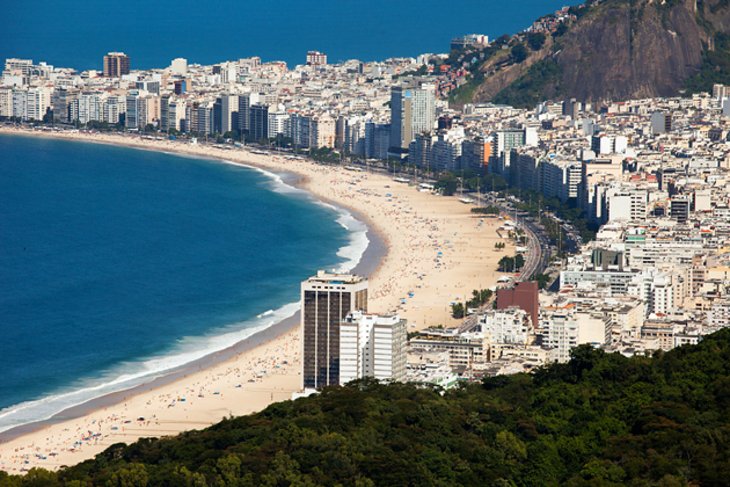Rio de Janeiro is the second major city in Brazil and was its capital from 1763 to 1960, when Brasília was created. The city was founded by Portuguese colonists in the mid 1500s and became the port for the shipment of gold from the inland mining areas. Throughout its history, Rio has seemed aware of its physical assets - the soaring mountains behind it, Sugar Loaf towering above its harbor, and its long crescent beaches that are its prime tourist attractions - and has enhanced that landscape with distinguished buildings from each era of its history and with a generous supply of urban parks and open spaces.
Rio de Janeiro's setting between the mountains and the sea is so spectacular that UNESCO cited "the staggeringly beautiful location for one of the world's biggest cities" in naming Rio a World Heritage Site. UNESCO's accolades weren't just for the natural setting but also for the urban cultural landscape and the mix of architecture and planned green space that characterized the city's growth.
1. Sugar Loaf
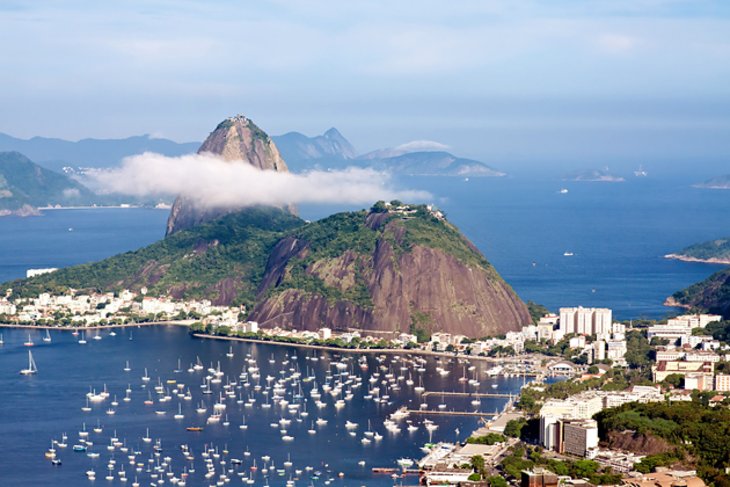 Rio de Janeiro's best-known landmark is the rock peak of Sugar Loaf, towering 394 meters above the harbor. It sits on a point of land that projects out into the bay and wraps around its harbor, and is connected to the city by a low strip of land. You can take a cable car from Praça General Tibúrcio to the top of the Morro da Urca, a lower peak from which a second cableway runs to the summit of the Sugar Loaf. From here, you can see the entire mountainous coast that rings the bay and its islands. Below, the 100-meter Praia da Urca beach is near the location of Rio's original nucleus, between the Morro Cara de Cão and the Sugar Loaf. On Cara de Cão are three forts, of which the 16th-century star-shaped Fort São João is open to the public.
Rio de Janeiro's best-known landmark is the rock peak of Sugar Loaf, towering 394 meters above the harbor. It sits on a point of land that projects out into the bay and wraps around its harbor, and is connected to the city by a low strip of land. You can take a cable car from Praça General Tibúrcio to the top of the Morro da Urca, a lower peak from which a second cableway runs to the summit of the Sugar Loaf. From here, you can see the entire mountainous coast that rings the bay and its islands. Below, the 100-meter Praia da Urca beach is near the location of Rio's original nucleus, between the Morro Cara de Cão and the Sugar Loaf. On Cara de Cão are three forts, of which the 16th-century star-shaped Fort São João is open to the public.
2.Cristo Redentor (Christ the Redeemer)
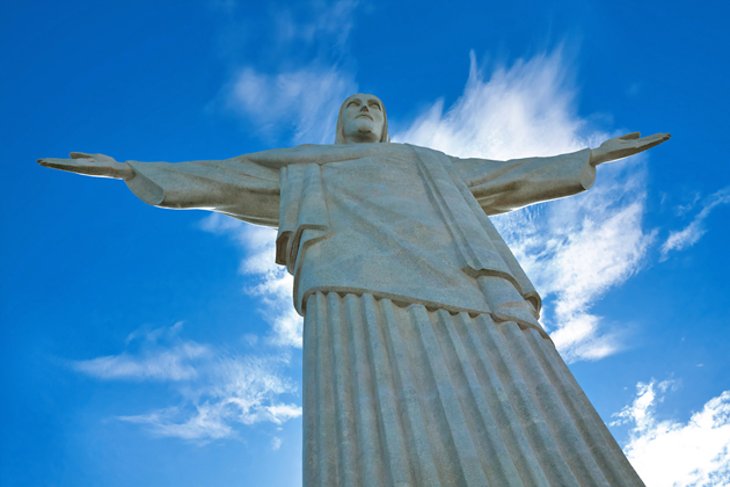
The giant statue of Christ overlooking the city from the 709-meter summit of Corcovado is almost as widely recognized a symbol of Rio as the distinctive shape of Sugar Loaf. The world-famous landmark was erected between 1922 and 1931, financed almost entirely by contributions from Brazilian Catholics.
The Art Deco statue was created by Polish-French sculptor Paul Landowski and built by the Brazilian engineer Heitor da Silva Costa, in collaboration with the French engineer Albert Caquot. Made of reinforced concrete and soapstone, the figure itself is 30 meters tall with arms stretching 28 meters; it weighs 635 metric tons. Inside its eight-meter-high base is a chapel, where it's not uncommon to find weddings and baptisms taking place. The Corcovado rack railway chugs from Rua do Cosme Velho up the 3.5-kilometer track to the statue, through the Tijuca National Park.
3. Carnival

One of the world's most famous pre-Lenten celebrations - as well-known as those inVenice and New Orleans - takes place each winter in Rio de Janeiro. The celebrations begin shortly after New Year, but the splendor and extravagance reaches its spectacular climax in the four days before Ash Wednesday, attracting hundreds of thousands of spectators to its street parades, samba parties, and shows. Other Brazilian cities celebrate Carnaval; it is also a major tourist event in Bahia and Recife, but Rio's is the most lavish.
The most spectacular events are the parades of the samba schools, which are held in a unique venue designed by renowned Brazilian architect Oscar Niemeyer. TheSambódromo is a long parade route lined by stadium-style boxes designed so that up to 50,000 spectators can watch the parades of brilliantly costumed dancers as they compete. The parade route is 700 meters long and 13 meters wide. It was first used in 1984 and updated as a venue for the 2016 Olympic Games.
Address: Rua Marquês de Sapucaí, Rio de Janeiro
4. Copacabana
Few cities are blessed with a beautiful sand beach at its heart, let alone one that stretches four kilometers along one entire side of its downtown. A few steps from its golden sands are Avenida Atlântica, Avenida Nossa Senhora de Copacabana, and the neighboring smaller streets where you'll find appealing century-old buildings, fine hotels, and popular restaurants and cafés. The unquestioned monarch of the area, and of Rio hotels, is the renowned Copacabana Palace, built in the 1920s and now protected as a national monument. Featured in the 1933 film Flying Down to Rio and host to royalty and glamorous movie stars, Copacabana Palace recalls the halcyon days of power, wealth, and elegance, when Rio was capital of Brazil.
At the far end of the beach, Copacabana Fort dates from 1914 and was the scene of a 1922 revolt of officers, who took over the fort and turned its artillery on the city. The short-lived revolt ended the next day when the government brought in battleships to bombard the fort. You can learn about this and other military history at the Museu Histórico do Exército (Museum of the History of the Army) now housed here. Outside, on the fort grounds, are artillery pieces from the late 19th and early 20th centuries.
5 Tijuca National Park
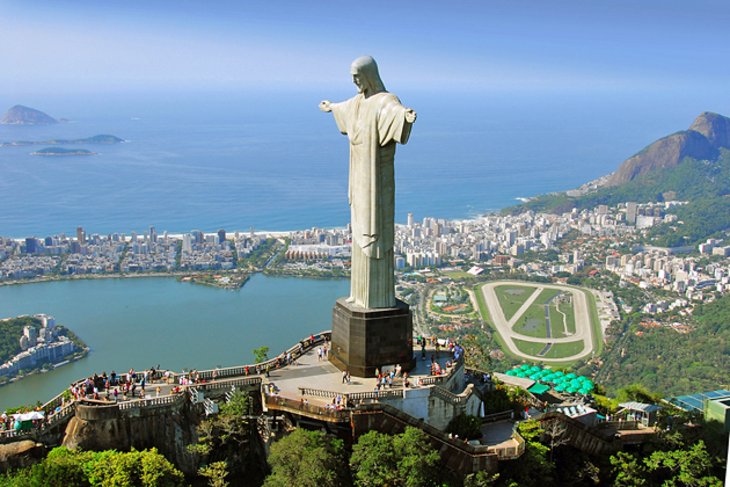
Tijuca National Park protects the Tijuca Forest and several viewpoints overlooking the city, and surrounds Cristo Redentor, the giant-sized statue of Christ on Corcovado. To explore the park, you can leave the train up to Corcovado at a midpoint and follow the road through the forest. The 3,300-hectare Tijuca Forest, one of the world's largest forests within a city, was planted in the late 1850s on land that had been destroyed by coffee plantations, to safeguard the springs that supplied Rio de Janeiro's water. Most of the trees are native species and provide habitat for Capuchin monkeys, quatis (Brazilian raccoon), colorful toucans, hawks, brilliant blue butterflies, and many other species of wildlife, which you may spot while exploring its trails and roads.
Near the station of the Corcovado railway is Largo do Boticário, one of Rio's most picturesque squares, surrounded by colonial-style houses. From the pagoda-style pavilion at Morro da Vista Chinesa, 380 meters above the shore, are views of the Municipal Park, the Botanic Garden, and a long stretch of the south coast. There are more views from Mirante Dona Marta, a viewpoint on a spur of rock above Botafogo Bay. Several waterfalls drop from the forest springs, including the 30-meterCascatinha Taunay. Set in extensive gardens near the park is the Museu do Açude, with the valuable porcelain collections of the West India Company; old views of Rio de Janeiro by Brazilian and foreign artists; and azulejos, traditional Portuguese tiles from the 17th through 19th centuries.
6. Passeio Público and Cinelândia
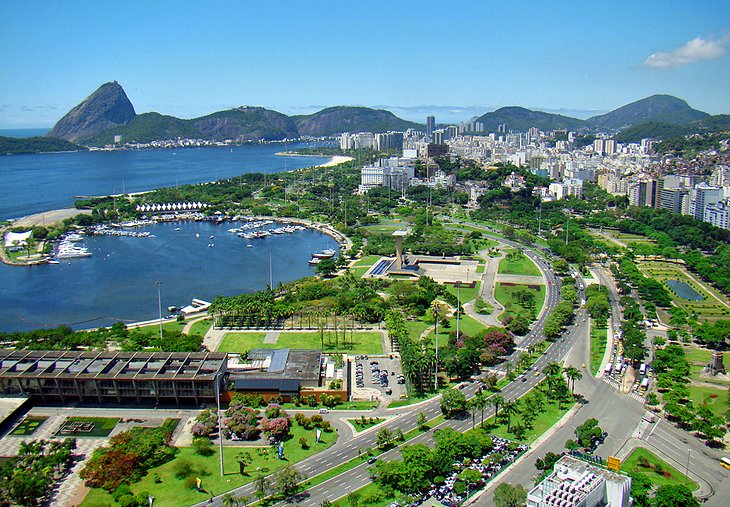
Stretching along Avenida Beira-Mar, Passeio Público is an attractive park designed in 1779 by a group of artists. Brazil's oldest public park and one of the oldest in the Americas, it is filled with sculptures by Mestre Valentim and pavilions with paintings by Leandro Joaquim, two of the park's designers. The Baroque entrance, a stone staircase, fountains, and statues of figures from mythology provide focal points in this expansive green space. To its east along the bay is Parque do Flamengo and the Marina da Glória, with gardens designed by Burle Marx, and the modernist Monumento aos Mortos, a memorial to the dead of World War II. At the north end of Flamengo Park is the Museum of Modern Art.
Adjoining the Passeio Público is the Cinelândia district, one of Rio's political and cultural centers, filled with magnificent public buildings from the first decades of the 20th century, after Rio de Janeiro became capital of Brazil. The Academia Brasileira de Letras (Academy of Letters) occupies a building in Avenida Presidente Wilson, modeled on the Petit Trianon at Versailles. It was donated to the city by the French government in 1923 to house a society established in the late 19th century by a group of writers and poets inspired by the Académie Française. The society's purpose is to safeguard the Brazilian Portuguese language and promote Brazilian literature.
7.São Francisco da Penitência
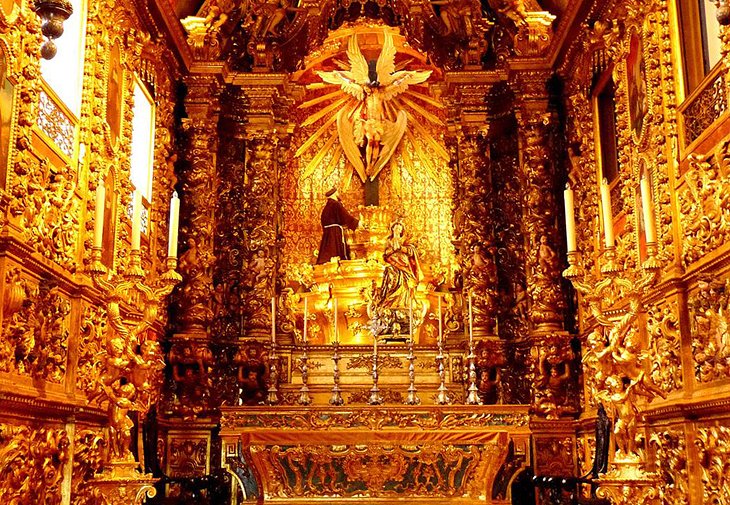
The Igreja da Ordem Terceira de São Francisco da Penitência is divided into three sections with separate entrances, and the simple façade of this church belies the riches within. The interior, which was begun in 1657 and completed in 1773, is a riot of gilded wood carving. Among those who contributed to the decoration of the interior were Manuel and Francisco Xavier de Brito, two leading Portuguese sculptors and woodcarvers. They had very similar styles, known as Brito, using decorative forms that influenced Aleijadinho and other masters of Brazilian Baroque. The ceiling of the choir has the earliest trompe-l'oeil painting in Brazil, completed in 1736, the work of Caetano da Costa Coelho, who later painted the ceiling of the nave in the same style.
8.Ipanema and Leblon
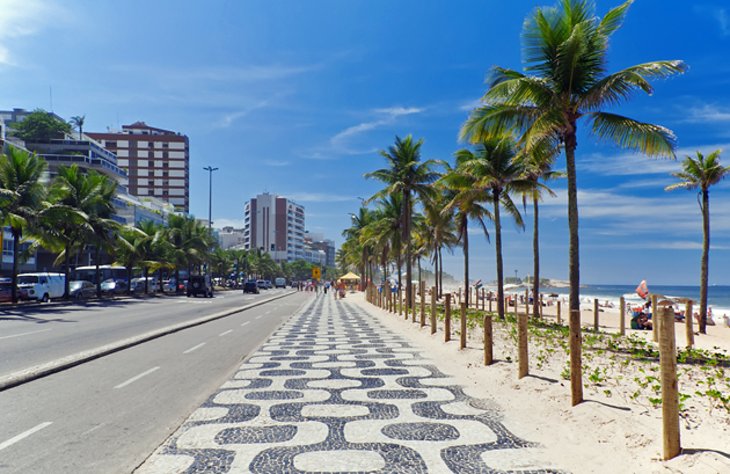
Continuing on from Copacabana's four-kilometer strand, the beaches of Ipanema and Leblon are separated by the Jardim de Alá Canal, which drains the lagoon, Lagoa Rodrigo de Freitas. Along the seafront promenade are large hotels, sidewalk cafés, and restaurants. These two districts, although best known for their beaches (one of which was made world-famous by the song Girl from Ipanema) have a lively cultural life, with art galleries, cinemas, and an avant-garde theater. Praça de Quental in Leblon is the scene of an antiques market every Sunday, and Praca General Osorio hosts the Sunday Feira de Artesanato de Ipanema featuring crafts, music, art, and local foods.
The shore of Lagoa Rodrigo de Freitas is lined by parks and sports clubs, and its waters are popular for regattas and other water sports. On the west side of the lagoon, the Jardim Botânico (Botanic Garden) has more than 5,000 species of plants from all over the world, including water lilies and other plants from the Amazon region.
Where to Stay in Rio de Janeiro for Sightseeing
Rio de Janeiro stretches between the bay and mountains, its attractions so spread out that there is no neighborhood convenient to more than a few of them. Fortunately, Rio's Metro system is fast and efficient, so the best hotels for tourists are in the safe beach neighborhoods of Copacabana and Ipanema, amid restaurants and shops and handy to Metro access. Another option is Botafogo, a residential area adjacent to Copacabana, near the cable car to Sugarloaf. Here are some highly-rated hotels in Rio de Janeiro.
- Luxury Hotels: Featuring a scenic rooftop pool, Miramar Hotel by Windsor is right on Copacabana beach, where sun chairs and umbrellas are available for guests; it's a short walk from Ipanema. Belmond Copacabana Palace is an icon of Copacabana's reputation for sophistication and glamor, a place where film stars and royalty have basked in Old World elegance. The rooftop pool at JW Marriott Hotel Rio de Janeiro overlooks Copacabana beach (umbrellas and chairs are reserved for guests) and there is a spa and fitness center.
- Mid-Range Hotels: A block off the beach, friendly Ipanema Inn offers personal service in the midst of Ipanema's vibrant dining and arts scene. On a quiet street in the heart of Copacabana, Hotel Sesc Copacabana is a block from the beach and surrounded by restaurants and shops. Also a block off the beach, Windsor Palace Hotel has a small rooftop pool, a large breakfast buffet, and free airport shuttle.
- Budget Hotels: Ibis Copacabana Posto 5 is a few blocks off the beach and near the Metro station, with plenty of dining options nearby. Close to the Metro in residential Botafogo, one stop from Copacabana, Ibis Rio de Janeiro Botafogo is near the Sugarloaf cable car. So is Mercure Botafogo Mourisco, whose higher rooms have a view of Christ the Redeemer on Corcovado.
